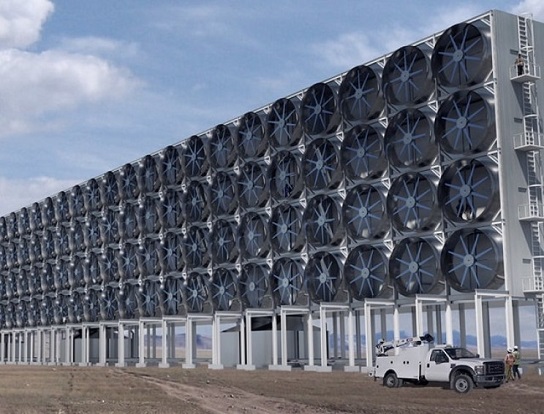With its plenty of formation outcome, Carbon dioxide, the ultimate end product of many man-made and natural processes have become a great pollution hazard in the present times. Various technological methods/techniques are being developed not only to slash/control the emission of carbon dioxide but also to make its use from its ever increasing atmospheric concentration through direct-air capture of atmospheric carbon. The projects have their importance as manyclimate experts warn that current measures to reduce emissions-such as adopting renewable energy and electrifying transportation-are no longersufficient to avert catastrophe.To limitglobal warming to 1.5 °C, the world must also use “negative-emission technologies,” according to the United Nations Intergovernmental Panel on Climate Change’s2018 report.Global CO2 emissions from fossil fuelsreached 33 billion metric tonsin 2019.
A facility at west Texas (USA) with rows of giant fans spread across a flat, arid field will pull carbon dioxide from the air and then pump it deep underground. When completed, the projectcould capture 1 million metric tons of carbon dioxide per year, doing the air-scrubbing work of some 40 million trees.Canadian firm Carbon Engineering is designing and building this “direct-air capture” facility and will devote much of 2021 to front-end engineering and design work with construction slated to start the following year and operations by 2024.The project is the biggest of its kind in the world and will likely cost hundreds of millions of dollars to develop. Similarly, other companies like Zurich-based is expanding across Europe, while Dublin’s Silicon Kingdom Holdingsplans to install its first CO2-breathing “mechanical tree” in Arizona. Global Thermostat, head quartered in New York City, has three new projects in the works. All the companies say they intend to curb the high cost of capturing carbon by optimizing technology, reducing energy use, and scaling up operations.
Carbon Engineering’s plantin in Texas will use banks of fans, each about 8.5 meters in diameter, to draw air into a large structure called a contactor. The air is pushed through a plastic mesh coated with a potassium hydroxide solution, which binds with the carbon dioxide. A series of chemical processes concentrate and compress the CO2into tiny white pellets, which are then heated to 900 °C to release the carbon dioxide as a gas. At its pilot plant in British Columbia, Carbon Engineering combines the pure CO2with hydrogen to produce synthetic crude oil. The facility can capture 1 metric ton of carbon dioxide per day; by comparison, the Texas operation is expected to capture over 2,700 metric tons daily. At the larger site, the captured gas will be injected into older oil wells, both sequestering the CO2 underground and forcing up any remaining oil. In addition to the work in Texas, the company is scaling up its Canadian operations.In 2021, it will open a new business and advanced-development center and expand research operations; the new facility will capture up to 4 metric tons of CO2 per day from the air.
Existing direct-air capture projects would eliminate a tiny fraction of that total, and not all of the captured CO2 is expected to be permanently sequestered. Some of it will likely return to the atmosphere when used in synthetic fuels or other products. Companies say the goal is to continuously capture and “recycle” the greenhouse gas to avoid creating new emissions, while also generating revenue that can fund the technology.Carbon removal can help compensate for sectors that are difficult to decarbonize, such as agriculture, cement making, and aviation.It is believed that the world will have to remove 50 billion metric tons of carbon dioxideover the next two decades to avoid catastrophic climate shifts. Global energy giantsare also backing direct-air capture to undo some of the damage caused by their products and operations. Other direct-air capture firms are opting for a modular approach. Climeworks’ carbon collectors can be stacked to build facilities of any size. The system also uses fans, but the air runs over a solid filter material. Once saturated with CO2, the filter is heated to between 80 and 100 °C, releasing highly concentrated CO2 gas, which can be used in various ways.
